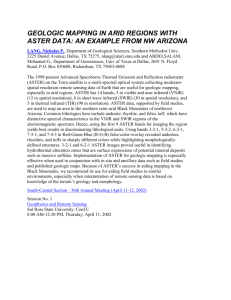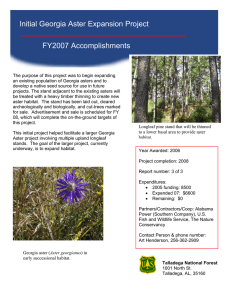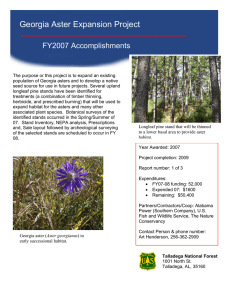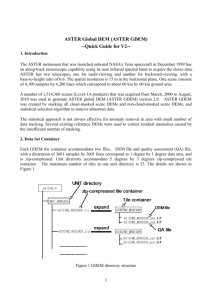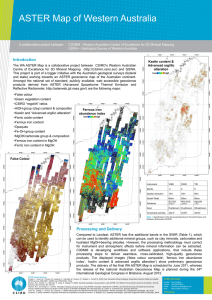THE ACCURACY ASSESSMENT EXPERIMENTOF ASTER 3D ORTHO PRODUCT IN BEIJING AREA
advertisement
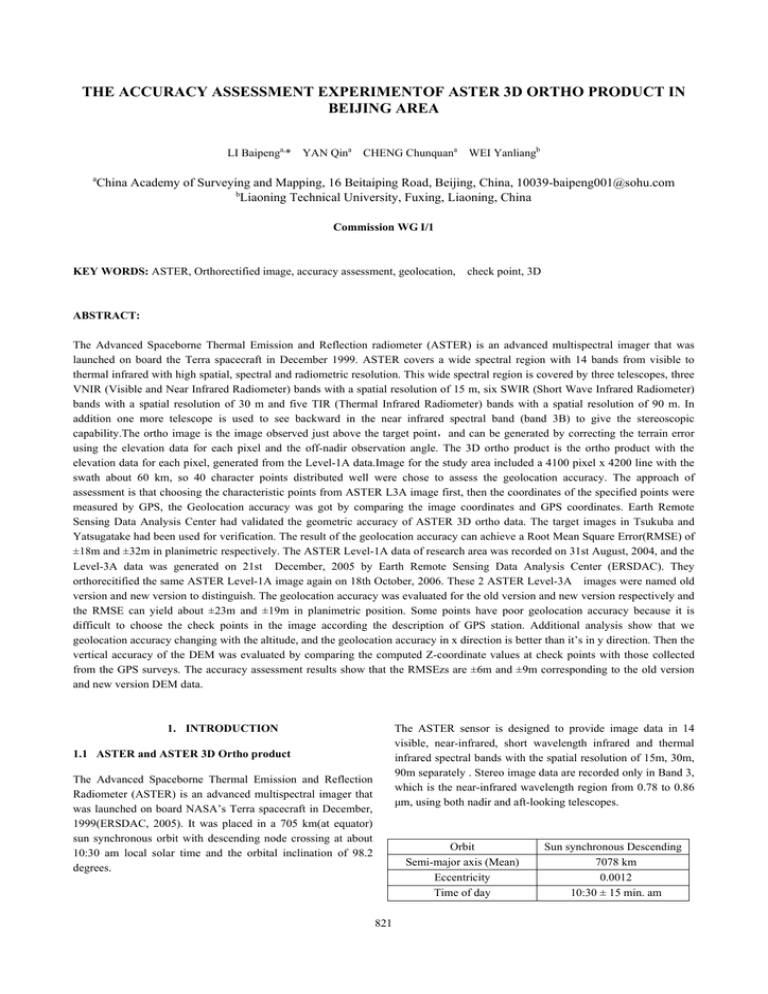
THE ACCURACY ASSESSMENT EXPERIMENTOF ASTER 3D ORTHO PRODUCT IN BEIJING AREA LI Baipenga,* YAN Qina CHENG Chunquana a WEI Yanliangb China Academy of Surveying and Mapping, 16 Beitaiping Road, Beijing, China, 10039-baipeng001@sohu.com b Liaoning Technical University, Fuxing, Liaoning, China Commission WG I/1 KEY WORDS: ASTER, Orthorectified image, accuracy assessment, geolocation, check point, 3D ABSTRACT: The Advanced Spaceborne Thermal Emission and Reflection radiometer (ASTER) is an advanced multispectral imager that was launched on board the Terra spacecraft in December 1999. ASTER covers a wide spectral region with 14 bands from visible to thermal infrared with high spatial, spectral and radiometric resolution. This wide spectral region is covered by three telescopes, three VNIR (Visible and Near Infrared Radiometer) bands with a spatial resolution of 15 m, six SWIR (Short Wave Infrared Radiometer) bands with a spatial resolution of 30 m and five TIR (Thermal Infrared Radiometer) bands with a spatial resolution of 90 m. In addition one more telescope is used to see backward in the near infrared spectral band (band 3B) to give the stereoscopic capability.The ortho image is the image observed just above the target point,and can be generated by correcting the terrain error using the elevation data for each pixel and the off-nadir observation angle. The 3D ortho product is the ortho product with the elevation data for each pixel, generated from the Level-1A data.Image for the study area included a 4100 pixel x 4200 line with the swath about 60 km, so 40 character points distributed well were chose to assess the geolocation accuracy. The approach of assessment is that choosing the characteristic points from ASTER L3A image first, then the coordinates of the specified points were measured by GPS, the Geolocation accuracy was got by comparing the image coordinates and GPS coordinates. Earth Remote Sensing Data Analysis Center had validated the geometric accuracy of ASTER 3D ortho data. The target images in Tsukuba and Yatsugatake had been used for verification. The result of the geolocation accuracy can achieve a Root Mean Square Error(RMSE) of ±18m and ±32m in planimetric respectively. The ASTER Level-1A data of research area was recorded on 31st August, 2004, and the Level-3A data was generated on 21st December, 2005 by Earth Remote Sensing Data Analysis Center (ERSDAC). They orthorecitified the same ASTER Level-1A image again on 18th October, 2006. These 2 ASTER Level-3A images were named old version and new version to distinguish. The geolocation accuracy was evaluated for the old version and new version respectively and the RMSE can yield about ±23m and ±19m in planimetric position. Some points have poor geolocation accuracy because it is difficult to choose the check points in the image according the description of GPS station. Additional analysis show that we geolocation accuracy changing with the altitude, and the geolocation accuracy in x direction is better than it’s in y direction. Then the vertical accuracy of the DEM was evaluated by comparing the computed Z-coordinate values at check points with those collected from the GPS surveys. The accuracy assessment results show that the RMSEzs are ±6m and ±9m corresponding to the old version and new version DEM data. The ASTER sensor is designed to provide image data in 14 visible, near-infrared, short wavelength infrared and thermal infrared spectral bands with the spatial resolution of 15m, 30m, 90m separately . Stereo image data are recorded only in Band 3, which is the near-infrared wavelength region from 0.78 to 0.86 μm, using both nadir and aft-looking telescopes. 1. INTRODUCTION 1.1 ASTER and ASTER 3D Ortho product The Advanced Spaceborne Thermal Emission and Reflection Radiometer (ASTER) is an advanced multispectral imager that was launched on board NASA’s Terra spacecraft in December, 1999(ERSDAC, 2005). It was placed in a 705 km(at equator) sun synchronous orbit with descending node crossing at about 10:30 am local solar time and the orbital inclination of 98.2 degrees. Orbit Semi-major axis (Mean) Eccentricity Time of day 821 Sun synchronous Descending 7078 km 0.0012 10:30 ± 15 min. am The International Archives of the Photogrammetry, Remote Sensing and Spatial Information Sciences. Vol. XXXVII. Part B1. Beijing 2008 Altitude range Inclination Repeat cycle Distance between adjacent orbits Orbit period Orbit position knowledge Repetition accuracy 700 - 737 km (705 km at equator) 98.2° ± 0.15° 16 days (233 revolutions/16days) 172 km TIR 98.9 min 150 m/3 axes ±20 km Table 1-2 ASTER has 14 bands from visible to thermal infrared region, which enables to provide more information than that provided by Landsat/TM, ETM+, a representative earth observation sensor. More specifically, Landsat/TM, ETM+ has 2 bands in short wave infrared region (SWIR), whereas ASTER has 6 bands in the region. Thanks to this, ASTER data is applicable to define minerals and rocks in resource exploration, environmental monitoring such as vegetation, monitoring of volcanic activity and others. In thermal infrared region (TIR), Landsat/TM, ETM+ has only one band, while ASTER has 5 bands. This is why ASTER is expected to contribute greatly in fields, which require highly accurate temperature and emissivity detection such as identification of ores (felsite from mafic rock), studies on cloud, evapotranspiration, heat island effect in urban areas, monitoring of volcanic activity, heated effluent and others. VNIR SWIR Spectral range(μm) 0.52 - 0.60 0.63 - 0.69 0.78 - 0.86 0.78 - 0.86 1.600 - 1.700 2.145 - 2.185 2.185 - 2.225 2.235 - 2.285 2.295 - 2.365 90 m The Sensor Character of ASTER The ASTER instrument has two types of Level-1 data: Level-1A and Level-1B data. Level-1A data are formally defined as reconstructed, unprocessed instrument data at full resolution. According to this definition, the ASTER Level-1A data consist of the image data, the radiometric coefficients, the geometric coefficients and other auxiliary data without applying the coefficients to the image data to maintain the original data values. The Level-1B data are generated applying these coefficients for radiometric calibration and geometric resampling. The ortho image is the image observed just above the target point. This means the ortho image includes no terrain error. The ortho image can be generated by correcting the terrain error using the elevation data for each pixel and the off-nadir observation angle. The 3D ortho product is the ortho product with the elevation data for each pixel, generated from the Level-1A data. Its formal name is Level-3A01. Figure 1-1 shows the relationship between the 3D ortho data and the source data. Another pronounced feature of ASTER is the capability to collect information, which leads to the production of stereoscopic data by combining them with high spatial resolution spectral information. ASTER band3 in VNIR (0.78 -0.86μm) can observe nadir-looking (3N) and backward looking (3B) data simultaneously. Stereoscopic data can be produced by the combination of these data. Also, based on the stereoscopic data, digital elevation model (DEM) can be processed. Band number 1 2 3N 3B 4 5 6 7 8 2.360 - 2.430 8.125 - 8.475 8.475 - 8.825 8.925 - 9.275 10.25 - 10.95 10.95 - 11.65 In this way, ASTER data can add three-dimensional information on topographic map. Accuracy of DEM data could vary in areas but the maximum error on ground surface is up to 50m and the maximum elevation error is up to 15m. The following image shows an example of bird’s eye view image processed based on ASTER DEM data. Table 1-1 The Orbit Parameters of Terra Satellite subsystem 9 10 11 12 13 14 The instrument geometric parameters such as the line of sight (LOS) vectors and the pointing axis vectors were precisely adjusted through a validation process using numerous GCPs. The DEM data, which is processed using only these system parameters, has been demonstrated to have extremely good accuracy. Space resolution In 3D ortho data processing, the level-1A data is used as input image data. Moreover, the Level-4A01X(DEM XYZ) data is used as geolocation information for providing ortho graphic projection and map coordinates projection features to the Level-1A data. After performing collection to the Level-1A data and the DEM data, a geometric conversion is performed on the image data. At that time, the SWIR parallax errors in the along-track direction due to the detector alignment and in the cross-track direction due to the Earth rotation are also corrected. 15 m 30 m 822 The International Archives of the Photogrammetry, Remote Sensing and Spatial Information Sciences. Vol. XXXVII. Part B1. Beijing 2008 DEM Data Set (Level-4A01 Product) Level-1A Data Set Preprocessing Preprocessing • Cross-wise Interpolation • Sea Surface Interpolation • Smoothing • Radiometric Correction • Bad Pixel Interpolation • Strip Removal SWIR Parallax Calculation • Along-Track Parallax • Cross-Track Parallax Geometric Correction • Coordinate Transformation • Terrain Error Correction 3D Ortho Data Set (Level-3A01 Product) Figure 1-1 3D Ortho Product Generation Algorithm Flow The 3D ortho product generated is image data that has been subjected to ortho graphic projection processing and map coordinates projection processing. The DEM Z (elevation) data generated from the Level-4A01 X data for geolocation information on the image data, and DEM quality flag data are attached to the 3D ortho product after performing the same transformation of coordinates as for the image data. The DEM data used in the data processing is useful as quality information and, at the same time, may improve users’ convenience if the DEM geometrically matching image data is attached. Up to till now, main emphasis has mainly given to the analysis of geolocation error of remote sensing imagery. Zhang Jixian(2000) researched the displacement of SPOT images, M.S.Hashemiana(2004) evaluated the accuracy of DEM generated form SPOT5 HRS imagies, Philip Cheng() described how to correct QuickBird data using different geometric correction model and the method of automatic DEM extraction using QuickBird stereo data. Wang Yali(2005) analyzed the SPOT5 geometric error applying the computer simulation technique, and A. M. Marangoz (2005) researched the geometric evaluation, automated DEM and orthoimage generation from along-track stereo ASTER Images. It’s difficulty to measure the Ground Control Point (GCP) by GPS or other method in the West Region of China where the 1:50,000 scaled terrain maps are absent, because of the mountainous terrain, rugged topography and abominable climate of those area. So it’s an important method to make the topographic map using the high-resolution remotely sensing imagery with high precision orientation parameter to extract DEM under the condition of lacking GCP, then the DEMs were used to make the ortho image. The aims of this paper is to assess the geolocation accuracy of ASTER L3A image. If the accuracy satisfies the requirement of China’s 1:50,000 map, then the ASTER image can be used in the Mapping Project in the West Region of China. 823 The International Archives of the Photogrammetry, Remote Sensing and Spatial Information Sciences. Vol. XXXVII. Part B1. Beijing 2008 2. THE ACCURACY ASSESSMENT OF IN BEIJING AREA ASTER L3A choose the character points in the image 2.2.1 The swath of ASTER image is 60 km, so we decided to choose 40 character points distributed well. Same with many satellite datasets: road crossings and the end of bridges can easily be selected as character points in ASTER scenes. In mountainous area, it’s difficulty to choose the character points because there are few roads and the roads always are not wide enough ( the ground resolution of ASTER image is 15m) to recognize, so other points such as turning points of a road was chosen as character points. The distribution of character points is shown in figure 2-1. 2.1 the terrain of Beijing area Beijing lies in the north of the North China Plain, at 39°56′ N and 116°20′E. The terrain of the Beijing area slopes from the northwest to the southeast. Mountains snake round the city's north, west and northeast, while the southeast part of the city is a plain that slopes gently toward the coast of the Bohai Sea. The Yongding, Chaobai and Juma rivers and the north section of the Grand Cannel crisscross the area under Beijing's jurisdiction. Most of the rivers originate from mountainous areas in the northwest, cut through mountains and zigzag through the plain in the southeast before emptying into Bohai Sea. It covers 16,807.8 square kilometers. Mountainous areas occupy 10,417.5 square kilometers, accounting for 62% of the city's landmass. The rest, 6390.3 square kilometers or 38% of the total, are flatland. measure the coordinates of the character points 2.2.2 The ground coordinates of the 40 character points were measured by GPS, and planimetric accuracy of these points can reach to 1 m. compare the coordinates difference 2.2.3 Since we have got the coordinates of the character points and their corresponding ground coordinates, so we can evaluate the geolocation accuracy using the following formula: RMSEx = ∑ ΔX RMSEy = 2 n ∑ ΔY n 2 (2-1) RMSE = RMSEx 2 + RMSEy 2 Where RMSE = Root Mean Square Error RMSEx = Root Mean Square Error in X direction RMSEy = Root Mean Square Error in Y direction ΔX = the coordinates difference in X direction ΔY = the coordinates difference in Y direction n = the number of the check points Figure 2-1 The Terrain of Testfield in Beijing Area and the Distribution of Check Points 2.2 assessment approach 2.3 result The geometric accuracy validation approach of ASTER Level-3A image is that choosing character points form the image first, then measuring the ground coordinates of the character points by Global Positioning System (GPS), and the geolocation accuracy was got by comparing the coordinates measured by GPS and the image coordinates. The ASTER Level-1A data of research area was observed at 31st August, 2004, and the Level-3A data was generated at 21st December, 2005 by Earth Remote Sensing Data Analysis Center (ERSDAC). They orthorecitified the same ASTER Level-1A image again at 18th October, 2006. These 2 ASTER Level-3A images were named old version and new version to distinguish them, and the geolocation accuracy was evaluated respectively. 824 The International Archives of the Photogrammetry, Remote Sensing and Spatial Information Sciences. Vol. XXXVII. Part B1. Beijing 2008 Figure 2-2 The Geolocation Accuracy of ASTER Level 3-A Image Some points have poor geolocation accuracy because it is difficult to choose the check points in the image according the description of GPS station. We can see the geolocation accuracy form figure 2-2, the arrow showed the displacement of character point corresponding to the ground check point, the start of the arrow is the coordinates of ground check point, and the end is the coordinates of image character point. The value of the geolocation error was extended 1000 times to show clearly. The black arrow showed the old version’s geolocation accuracy and the red arrow showed the new version’s. We can see that the new version can locate more precise than the old version. The Mean, Standard Deviation(Stdev.) and Root Mean Square Error(RMSE) of the character points are listed in the below table: Old Version New Version ΔX(m) ΔY(m) ΔX(m) ΔY(m) Mean -5.52 13.65 -0.70 3.56 Stdev. 12.75 13.92 11.83 15.05 RMSE 13.75 19.37 11.70 15.28 Figure 2-3 The Points Have Poor Geolocation Accuracy Table 2-1 the Geolocation accuracy of old version and new version The 40 check points were divided into 4 groups with 14 points, 10 points, 8 points, and 8 points, and the altitude range of each group was less than 50 meter, from 50 meter to 100 meter, from 100 meter to 200 meter, and greater than 200 meter respectively. 825 The International Archives of the Photogrammetry, Remote Sensing and Spatial Information Sciences. Vol. XXXVII. Part B1. Beijing 2008 Old version New version Altitude Range Number of point RMSEx <50 14 9.50 18.93 9.48 11.68 50-100 10 13.51 20.09 11.86 12.65 100-200 8 20.94 19.74 13.77 18.28 >200 8 15.04 23.75 15.43 23.17 40 13.92 19.62 11.85 15.47 RMSExy RMSEy RMSEx RMSEy 24.06 RMSEz = ∑ ΔZ n 2 (3-1) Where, RMSEz = the RMSE in Z direction. ΔZ = the coordinates difference in Z direction n = check point number The DEM accuracy is shown in figure 3-1, the arrow showed the altitude differece of character point corresponding to the ground check point in the Z direction, the start of the arrow is the altitude of ground check point, and the end is the altitude of image character point. The value of the altitude difference was extended 1000 times to show clearly. The black arrow showed the old version’s altitude difference and the red arrow showed the new version’s. Different with the geolocation accuracy, we can see that the old version is more precise in altitude. 19.49 Table 2-2 The Geolocation Accuracy of Each Group ( Unit Meter) we can see that the geolocation accuracy changing with the altitude, and the geolocation accuracy in x direction is better than it’s in y direction. The altitude difference was drawn in the following figure to show it clearly, and the dark red line represent altitude diffrence of the old version DEM, the sky-blue line represent 3. DEM ACCURACY The GPS was used to measure the altitude of check point, and the following formula was used to access the accuracy of DEM. Figure 3-1 DEM Accuracy the new version’s. and the altitude dirrenence in New version is bigger than that in old version. The trend of the line is similitude, which is to say that there is a system error between the two DEM, if the system error is removed then the accuracy of DEM will be more precise. 826 The International Archives of the Photogrammetry, Remote Sensing and Spatial Information Sciences. Vol. XXXVII. Part B1. Beijing 2008 large geolocation errors are due to an imperfect Earth nutation correction in Level-1 processing are reported. Altitude Diffe nce 25.00 15.00 Series and basic requirements of digital topographic maps constituted by China’s STATE BUREAU OF SURVEYING AND MAPPING prescribes that the RMSE of a feature point in chart to it’s nearest field control point may not exceed 0.5 mm in plain, and 0.75 mm in mountainous area on the 1:50,000 scale topographic map, in special difficult area the RMSE can be extended 0.5 time according to the terrain class. On the other words, the RMSE may not exceed 25m (0.5mm * 50,000 ) in plain and 37.5m (0.75mm * 50,000) in mountainous area. The RMSE of ASTER 3D ortho product is smaller than 25m in Beijing area, so it can satisfy the accuracy requirement of 1:50,000 scale topographic map. Value 5.00 -5.00 1 4 7 10 13 16 19 22 25 28 31 34 37 40 -15.00 -25.00 -35.00 Check Point Number Old Version New Version F igure 3-2 The Altitude Difference The accuracy of DEM can be calculated and listed in the following table: Max Min Mean Stdev. RMSE Old Version ΔZ(m) 13.52 -30.76 -0.93 6.02 6.02 New Version ΔZ(m) 18.77 -16.70 6.76 6.02 9.01 5. REFERENCES Earth Remote Sensing Data Analysis Center ( ERSDAC ), 2004. ASTER User’s Guide, Part III, 3D ortho product ( L3A01), Ver.1.1 Zhang Jixian, Zhang Yonghong, Lin Zongjian, 2000. Research on the displacement of SPOT images. Science of Surveying and Mapping(2000, 1). pp.19-22 Table 3-1 the Altitude Accuracy of DEM Akira Hirano, Roy Welch, Harold Lang, 2003. Mapping from ASTER stereo image data: DEM validation and accuracy assessment. Journal of Photogrammetry & Remote Sensing, pp. 356– 370 In this table, Max, Min, Mean, Stdev, RMSE mean are the max value, min value, mean value, standard deviation, and root mean square value of altitude difference. Form the table we can see that the mean value of altitude difference in new version is bigger than that in old version, and the old version has a smaller RMSE value, so we think the old version DEM is more precise. Grodecki, J., Dial, G., 2002. Ikonos geometric accuracy validation. PECORA / ISPRS Commission I, Denver, CO 2002, on CD. 4. CONCLUSION M. S. Hashemian a, A. Abootalebi a, F. Kianifar, 2004, Accuracy Evaluation of DEM Generation from SPOT5 HRS imageries. www.isprs.org/HRS/PDF/72.pdf Earth Remote Sensing Data Analysis Center had validated the geometric accuracy of ASTER 3D ortho data. The target images in Tsukuba and Yatsugatake had been used for verification. The result of the geolocation accuracy is shown below: Tsukuba Yatsugatake Δlon(m) Δlat(m) Δlon( m) Δlat(m) Avera ge -15.7 -1.6 -27 11.6 Stdev. 6.4 6.2 8.7 11.7 RMSE 16.9 6.4 28.4 16.5 Table A. M. Marangoz, G. Büyüksalih, İ. Büyüksalih, U. G. Sefercik, H. Akçın, 2004, Geometric Evaluation, Automated DEM and Orthoimage Generation from Along-Track Stereo ASTER Images.www.ipi.uni-hannover.de/html/publikationen/2004/pape r/Jac_etal_Cairo04.pdf Philip Cheng, Thierry Toutin, Yun Zhang, QuickBird Geometric Correction, Data Fusion, and Automatic DEM Extration.www.pcigeomatics.com/ services/support_center/tech_papers/acrs03_cheng.pdf 4-1 The Geolocation Accuracy of ASTER 3D Ortho Product in Tsukuba and Yarsugatake The geolocation accuracy in the target image of Tsukuba is bet-ter than that of in Yarsugatake. ERSDAC explained that the 827 The International Archives of the Photogrammetry, Remote Sensing and Spatial Information Sciences. Vol. XXXVII. Part B1. Beijing 2008 828
